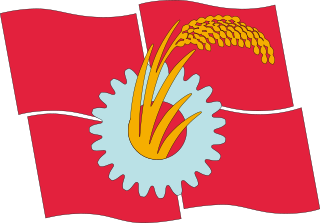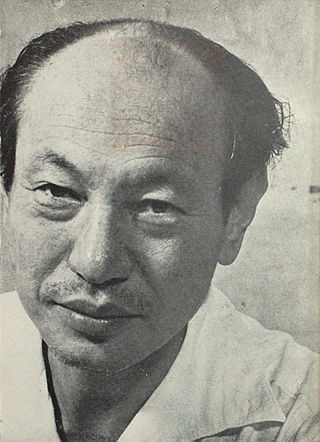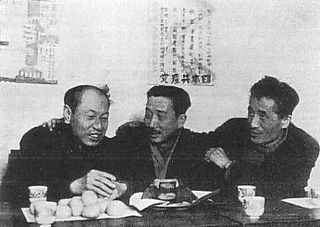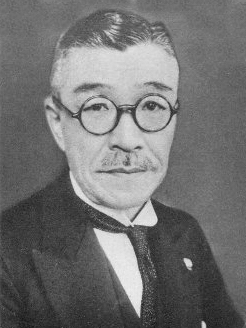
Japan was occupied and administered by the Allies of World War II from the surrender of the Empire of Japan on September 2, 1945, at the war's end until the Treaty of San Francisco took effect on April 28, 1952. The occupation, led by the American military with support from the British Commonwealth and under the supervision of the Far Eastern Commission, involved a total of nearly one million Allied soldiers. The occupation was overseen by the US General Douglas MacArthur, who was appointed Supreme Commander for the Allied Powers by the US President Harry S. Truman; MacArthur was succeeded as supreme commander by General Matthew Ridgway in 1951. Unlike in the occupations of Germany and Austria, the Soviet Union had little to no influence in Japan, declining to participate because it did not want to place Soviet troops under MacArthur's direct command.

The Japanese Communist Party is a communist party in Japan. Founded in 1922, it is the oldest political party in the country. It has 250,000 members as of January 2024, making it one of the largest non-governing communist parties in the world. The party is chaired by Tomoko Tamura, who replaced longtime leader Kazuo Shii in January 2024.

The Peace Preservation Law was a Japanese law enacted on April 22, 1925, with the aim of allowing the Special Higher Police to more effectively suppress alleged socialists and communists. In addition to criminalizing forming an association with the aim of altering the kokutai of Japan, the law also explicitly criminalized criticism of the system of private property and became the centerpiece of a broad apparatus of thought control in Imperial Japan. Altogether, more than 70,000 people were arrested under the provisions of the law until its repeal by Allied occupation authorities at the end of World War II.

Censorship in the Empire of Japan was a continuation of a long tradition beginning in the feudal period of Japan. Government censorship of the press existed in Japan during the Edo period, as the Tokugawa bakufu was in many ways a police state, which sought to control the spread of information, including Christianity, the influx of Western ideas, pornography and any political writings critical of the shōgun and government.

The Special Higher Police, often abbreviated Tokkō, was, from 1911 to 1945, a Japanese policing organization, established within the Home Ministry for the purpose of carrying out high policing, domestic criminal investigations, and control of political groups and ideologies deemed to threaten the public order of the Empire of Japan. As the civilian counterpart to the military police forces of the Kenpeitai (army) and of the Tokkeitai (navy), the Tokkō's functions were criminal investigation and counter-espionage. The Tokubetsu Kōtō Keisatsu was also known by various nicknames such as the Peace Police and as the Thought Police.

The Home Ministry was a Cabinet-level ministry established under the Meiji Constitution that managed the internal affairs of Empire of Japan from 1873 to 1947. Its duties included local administration, elections, police, monitoring people, social policy and public works. In 1938, the HM's social policy was detached from itself, then the Ministry of Health and Welfare was established. In 1947, the HM was abolished under the Supreme Commander for the Allied Powers restoration, then its administrative affairs were proceeded to the National Police Agency, the Ministry of Construction, the Ministry of Home Affairs and so on. In 2001, the MOHA was integrated with the Management and Coordination Agency and the Ministry of Posts and Telecommunications, then the Ministry of Public Management, Home affairs, Posts and Telecommunications was established. In 2004, the MPHPT changed its English name into the Ministry of Internal Affairs and Communications. In other words, the MIC is the direct descendant of the HM.

Kyuichi Tokuda was a Japanese politician and first chairman of the Japanese Communist Party from 1945 until his death in 1953.
Tenkō is a Japanese term referring to the coerced ideological conversions of Japanese socialists and communists who, between 1925 and 1945, were induced to renounce leftist ideologies and enthusiastically embrace the Emperor-centric, capitalist, and imperialist ideology favored by the state. Tenkō was typically performed under duress, most often in police custody, and was a condition for release. But it was also a broader phenomenon, a kind of cultural reorientation in the face of national crisis, that did not always involve direct repression.
Following Japan's defeat in World War II, the Allied Occupation of Japan ordered the purge of tens of thousands of designated persons from public service positions. Individuals targeted in the purge included accused war criminals, military officers, leaders of ultranationalist societies, leaders in the Imperial Rule Assistance Association, business leaders involved in Japanese overseas economic expansion, governors of former Japanese colonies, and national leaders involved in the decisions leading Japan into war. Ultimately, SCAP screened a total of 717,415 possible purgees, and wound up excluding 201,815 of them from holding public office. However, as part of the "Reverse Course" in Occupation policy, most of the purgees would be de-purged and allowed to return to public life by 1951.

Ikuo Oyama was a Japanese academic, politician, political scientist and writer.

Yoshio Shiga was a member of the Japanese Communist Party.
Appeal to the People or An Appeal to the People was a document written by communists in Shōwa era Imperial Japan in Fuchu Prison. It was issued after their release on October 10, 1945, a month after the Surrender of Japan on September 2, 1945.

Suehiko Shiono was a Japanese lawyer, politician and cabinet minister noted for his prosecution of high-profile cases of political crimes and thought crimes under the Peace Preservation Laws of the 1930s Empire of Japan.
The Omori bank robbery (大森銀行ギャング事件) was a bank robbery committed by members of the Japanese Communist Party in Ōmori-ku, Tokyo, Japan, in 1932. The bank robbery was dubbed the Omori Gang affair.
Political repression in Imperial Japan lasted from the Meiji period to the fall of the Empire of Japan after the end of World War II. Throughout this period, dissidence was curtailed by laws, and police, and dissidents became political prisoners.

John Kenneth Emmerson was an American diplomat, and specialist on Japan and Northeast Asia.
The Red Scare in Japan refers to the promotion of fear of the rise of communism and socialism in Japan.

Fuchū Prison is a prison in Japan. It is located in the city of Fuchū, Tokyo to the west of the center of Tokyo Metropolis. Before the end of World War II, Fuchū prison held Communist leaders, members of banned religious sects, and leaders of the Korean independence movement.

Eighteen Years in Prison is a Japanese autobiographical book by Kyuichi Tokuda and Yoshio Shiga.
The Red Purge was an anticommunist movement in occupied Japan from the late 1940s to the early 1950s. Carried out by the Japanese government and private corporations with the aid and encouragement of the Supreme Commander for the Allied Powers (SCAP), the Red Purge saw tens of thousands of alleged members, supporters, or sympathizers of left-wing groups, especially those said to be affiliated with the Japanese Communist Party, removed from their jobs in government, the private sector, universities, and schools. The Red Purge emerged from rising Cold War tensions and the Red Scare after World War II, and was a significant element within a broader "Reverse Course" in Occupation policies. The Red Purge reached a peak following the outbreak of the Korean War in 1950, began to ease after General Douglas MacArthur was replaced as commander of the Occupation by General Matthew Ridgway in 1951, and came to a final conclusion with the end of the Occupation in 1952.












